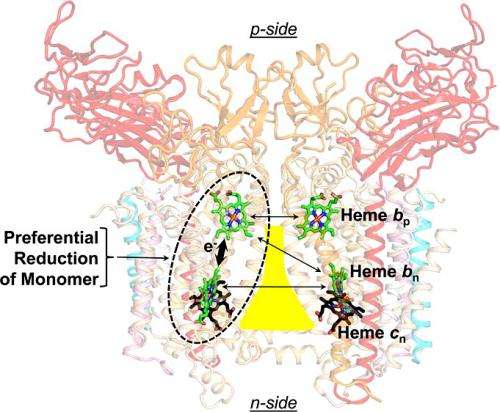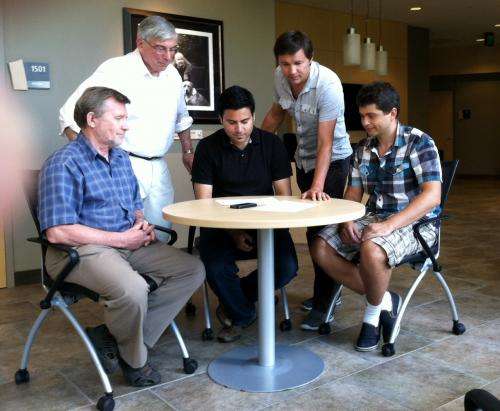Fat molecules influence form and function of key photosynthesis protein

(Phys.org) —A mysterious space within a protein critical to photosynthesis is filled with fat molecules that influence both the protein's architecture and electrical properties, according to two recent studies.
Researchers studied the atomic structure of, and electrical interactions within, the cytochrome bf complex, a protein complex central to the transport of electrons within membranes of a plant cell, a critical step in photosynthesis.
Photosynthesis is the process by which plants, algae and bacteria convert sunlight, carbon dioxide and water into chemical energy.
William Cramer, the Purdue University professor who led the studies, said the step in which electrons are transported in the cytochrome complex is one of the slowest steps in photosynthesis and is of particular interest to those involved in the effort to speed up the process.
"The ability to manipulate photosynthesis - to make it faster or more efficient - could improve some of the global issues we face," said Cramer, the Henry Koffler Distinguished Professor of Biological Sciences. "It could lead to crops that grow faster to help feed an increasing population, and it could lead to a source of clean energy. However, before we can meaningfully manipulate the proteins involved in photosynthesis, we need to understand their structure in detail."
Cramer and S. Saif Hasan, a graduate student whose doctoral thesis work laid the foundation for this project, used high-resolution X-ray crystallography to reveal that a cavity within the protein was filled with lipids, greasy molecules commonly called fats. The team found a total of 46 lipid-binding sites within the protein, and the discovery could change the way the biophysics-biochemistry community thinks about membrane proteins, Cramer said.

"It had been known that lipids created a boundary around the outside of membrane proteins, but finding them inside the protein could shift our thoughts on how these complexes work," he said. "These lipids must be there for a reason, and we are trying to determine exactly what that is."
The researchers suggest the lipids help stabilize the structure of the protein, assist in the formation of super-complexes that combine multiple protein complexes, and influence the ability to move an electric charge between different portions of the protein. A manuscript detailing these findings was published in the journal Structure.
Cramer, Hasan and Stanislav D. Zakharov, a senior research associate in Cramer's laboratory, then collaborated with Sergei Savikhin, an associate professor of physics, and graduate students Adrien Chauvet and Valentyn Stadnystskyi to examine the electrical interactions of the protein complex.
Through a new spectrophotometric technique that simultaneously measures both electron transfer within the cytochrome complex and strength of interactions that result from the transfer, the team discovered that the electrical interaction varied between the different parts of the protein complex involved in transporting electrons, called hemes.
The lipid-filled cavity, roughly shaped like a triangle with a bottleneck, divides the two halves of the protein complex, and each half contains two hemes. Two hemes sit across from each other near the top of the cavity's narrow neck, and the other two sit across from each other near its wide bottom. The researchers found that although the two hemes at the top are closer together, the preferred electron transfer was to the heme on the same side of the protein complex.
It had been thought that the internal environment of membrane proteins was characterized by an equal and small dielectric constant, a measure of the ability to store electrical energy in an electric field. However, electron transport preferentially going to the heme on the same side of the cavity is only possible if there is a relatively large dielectric constant that directs the electron that way, Cramer said.
The expected value for the dielectric constant was around 2.5, but the researchers found that dielectric constants between the hemes ranged from 4 to 44 under different experimental conditions.
"This dielectric heterogeneity was a surprise," Cramer said. "If it varies among the different hemes, there are functional consequences, and we plan to explore this."
The lipid that separates the hemes and two halves of the protein complex likely deters electron transfer in that direction because of its small dielectric constant, but this doesn't fully explain the size of the differences, he said.
Zakharov refined the spectrophotometric technique, which uses changes in light absorption to determine the location of electrons. When different parts of the protein complex interact, unique signals are generated and the height of the signal is an indication of the strength of the interaction, Cramer said. This information, coupled with knowledge of the structure from Hasan's studies, allowed the team to determine the dielectric constants.
The collaboration between biophysicists and physicists was essential to this project, Cramer said. A paper detailing the technique and findings was published in the Journal of Physical Chemistry B.
More information: "A Map of Dielectric Heterogeneity in a Membrane Protein: the Hetero-Oligomeric Cytochrome b6f Complex." S. Saif Hasan, et al. J. Phys. Chem. B, 2014, 118 (24), pp 6614–6625 DOI: 10.1021/jp501165k
Journal information: Structure , Journal of Physical Chemistry B
Provided by Purdue University




















